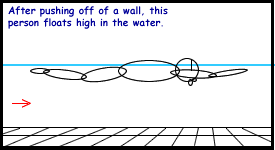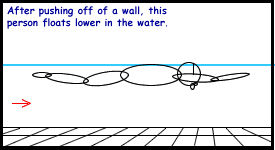
|
This section's pages: |
1.
Buoyancy
|
|
 |
Buoyancy
What is buoyancy?
As you float, your weight presses down into the water; the water presses back, pushing you up.
When
you get into the pool, your body displaces a volume of water (the "hole"
in the water that your body fits into). As long as the water your body
displaces weighs more than you do, you float.
This is basically Archimedes' Law.
You weigh less than the water you're in, because your lungs are full of air, like a balloon, and like a balloon, the air in your lungs lifts you to the surface naturally.
Why don't we float alike?
Everyone floats in the water at their own natural level.

Different factors contribute to how high — or low — in the water you float.
First, your body type has a lot to do with your buoyancy. Fat floats, as
you've probably heard, while your bones and muscles, denser than fat, are
not as willing to float.
Also, the relative size of your lungs to the rest of your body determines
how high in the water your body will float.
Second, the density of the water is a factor. Saltier water weighs more per unit of volume, so you will float higher in saltier water (the Red Sea, for instance) than you would in fresh water.
Finally,
there is a curious phenomenon of apparently greater buoyancy —
for some people — in deep water.
According to Melon
Dash of the Transpersonal Swimming Institute, “Buoyancy and
feeling buoyancy are two different things.
You can be buoyant but not feel buoyant.
Your buoyancy does not change between the shallow and the deep. Your
feeling of buoyancy may change.
“Feeling buoyancy in water is all about 'presence' in one's
body.
Presence — feeling while swimming — is most available when
a swimmer is not distracted by the pool bottom, or anything else.
“The pool bottom is closer in the shallow end and farther away
at the deep end.
Because it's so close in the shallow end and you know you can use it
any time, it may also be a distraction: some of your awareness, that
is, some of your attention or presence is on the bottom.
“When this distraction is not there in the deep end due to the fact that we can't use the bottom there, people often feel more buoyant in the deep: their awareness is all at the surface rather than part of their awareness being at the bottom, as in the shallow.”
A
factor
you CAN control is how relaxed you are. Tense muscles often keep your body
a bit lower in the water, since many people breathe more shallowly and rapidly
when tense (hence less air in the lungs for floating).
Did you ever play the “thinking heavy” game as a kid? You'd
be harder to pick up if you imagined yourself to be as heavy as a piano,
easier to pick up if you pretended to be a balloon.
Again, we each have our natural level of buoyancy. And then, there are those few who don't float at all (far fewer than people realize).
But no matter how low in the water you float or glide or swim, it has nothing to do with ultimately learning to swim. Period. You'll adjust your stroke, roll your face out a bit more to get your air, and swim.

Test your buoyancy
You'll need a pool, treading water skills for the deep end, a buddy and as always, a lifeguard.
-
Your buddy can sit on the pool ledge next to you, at the deep end. The lifeguard will also be close by.
-
Have your goggles on.
- Climb down the pool ladder's steps, facing the wall. As your face submerges you'll constantly bubble a thin stream of bubbles out through your nose to keep the water out. Keep your hands on the ladder's rail.
- Notice how you get pushed up as you go down? The deep you try to climb the harder it is to do. That's buoyancy at work.
updated 3/2/05
_![]() _________--------------
_________--------------
Home___How to Breathe___Phobia Help___Safety
Physics___ Schools & Gear ___Extra Goodies___Contact Me
| Buoyancy Facts: |
|
The buoyancy of water reduces your body weight by 90%. The stress upon weight-bearing joints, muscles and bones is also reduced. Body fat floats better than muscle. Women, older people and those who are not very muscular often have more fat than muscle even if they look slim. These people may float more easily. A full lungful of air acts like a balloon inside your body, helping to keep your chest afloat. Your legs tend to sink no matter how well you float. Lap swimmers hold a styrofoam "pull buoy" between their legs when they swim with arms only, to keep the legs from sinking and dragging behind them. |
|
You can swim no matter how you float. |
